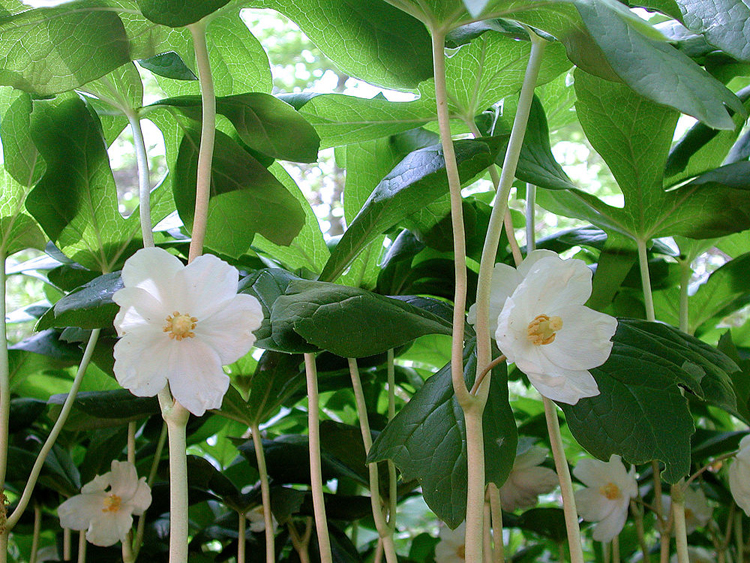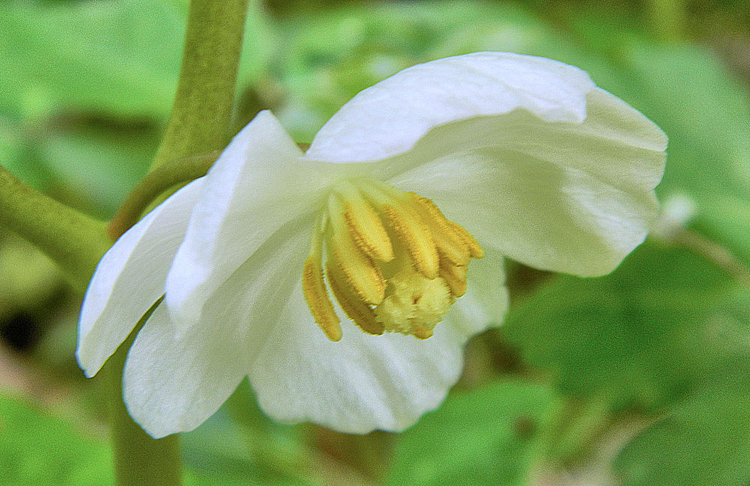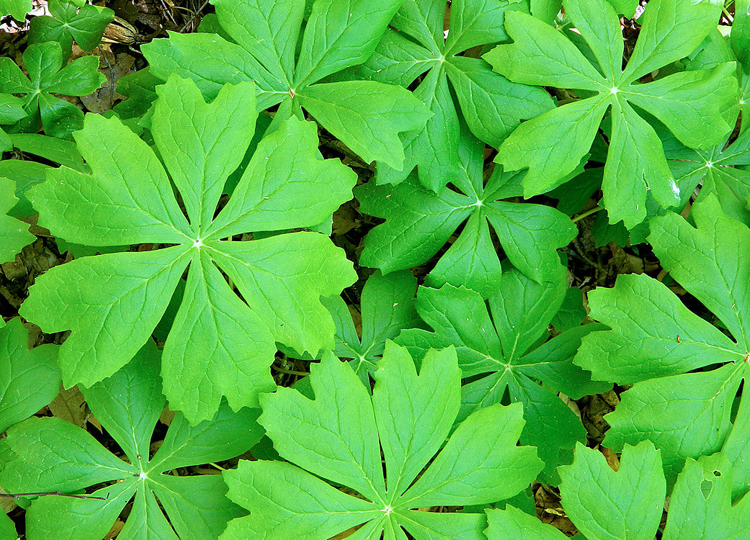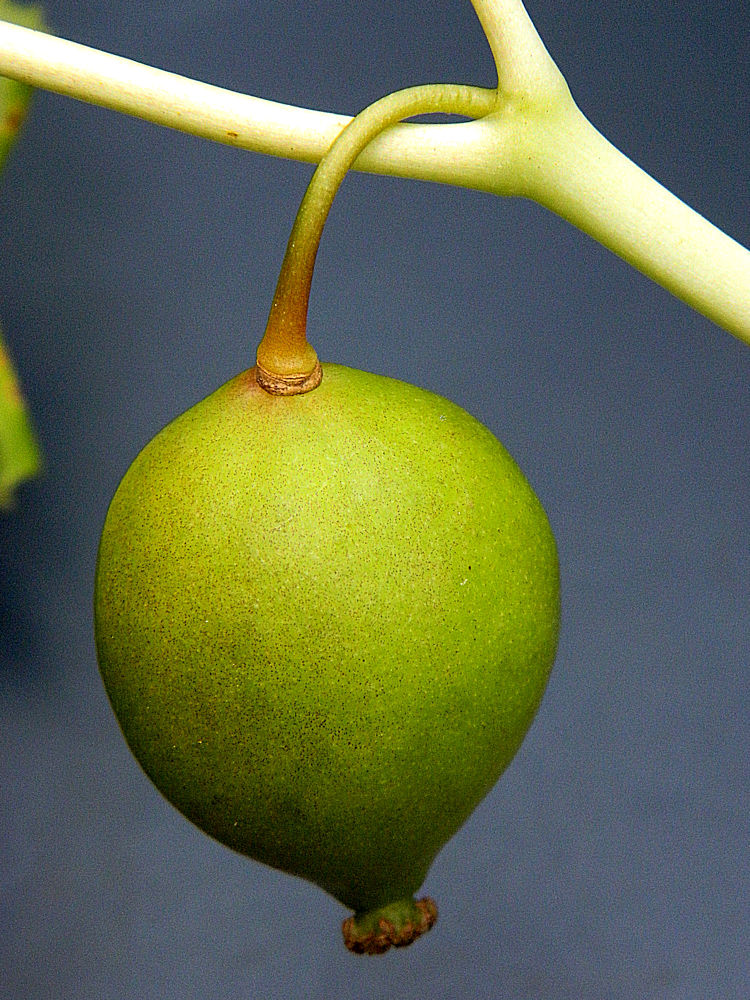Wildflower of the Year 2025: Mayapple (Podophyllum peltatum)
VNPS offers Mayapple artwork on T-Shirts and other apparel. Visit our Online Store to order.
Mayapples are perennial herbaceous plants with thick fibrous roots that arise from a creeping rhizome. Each year the rhizome elongates about 6 to 20 cm in length, terminating in a bud for the subsequent year’s leafy stem and one or more buds for continuation and branching of the rhizome. Over time rhizome branching results in the formation of large clonal colonies. Nonflowering aerial stems bear a single leaf whereas flowering stems produce a pair of leaves, between which a single flower is produced. As leaves first emerge in the spring, leaf blades initially droop downward, expanding later to a more or less horizontal position. Single leaves are alternate, paired leaves are subopposite; leaf blades are peltate, palmately lobed, and palmately veined, with smooth or coarsely toothed margins; leaf surfaces are smooth or, sometimes, slightly hairy on the underside. Flowers are solitary, nodding, fragrant, and about 2-5 cm broad. The three sepals drop promptly as the flower bud opens. Petals number 6 or 9 and are usually white. Stamens number twice that of the petals and range from 8 to 13 mm in length, 5 to 8 mm of which consists of the pollen-bearing anthers. The ovary is a nearly cylindrical single carpel, 6-12 mm long, topped by a very short style and somewhat convoluted stigma 3-5 mm in height. Fruits are fleshy yellow berries 2.5-5 mm long that ripen in mid-summer; aerial portions of the plant senesce shortly after fruit maturation.

Across the range of Podophyllum peltatum in eastern North America, a number of naturally occurring genetic variants of Mayapple have been found: flowering stems can be leafless in forma aphylla; flowering stems may bear three leaves; aerial stems and flowers may be pale pink; ovaries and fruits may consist of 2 to 8 carpels in forma polycarpum; and fruit color can be orange in forma biltmoreana, or red in forma deamii.

Name & Relationships
Podophyllum peltatum was named by Linnaeus in his seminal work, Species Plantarum. Podophyllum translates, somewhat cryptically, as “foot leaf.” The species portion of the scientific
name means shield-shaped, a reference to the way petioles join at the middle of the leaf blade as opposed to its margin. Current taxonomy recognizes just a single species in the genus Podophyllum; several Asian species formerly classified in Podophyllum now constitute the genera Dysosma and Sinopodophyllum. Mayapples are classified in the Barberry family, Berberidaceae, along with two other Virginia plants of similar growth habit, Diphyllea cymosa, Umbrella-leaf, and Jeffersonia diphylla, Twinleaf.
In the Wild
Mayapples frequent mesic to dry-mesic upland forests, well-drained floodplain forests, and various moist, disturbed habitats. The flowers are capable of self- or cross-pollination. Pollinating insects include bumblebees and other long-tongued bees, butterflies, and moths. The flowers produce no nectar, but nutritious pollen serves as pollinator reward. Mayapples are included among the several host plants utilized by caterpillars of the Variegated Fritillary; several moth caterpillars also feed on the plant. Ripe fruits are consumed by small mammals and box turtles.

In the Garden
Because of its tendency to form large colonies, Mayapples can become rampant in garden settings; further, the plants are dormant outside of spring and early summer. Consequently, these plants are better suited for naturalistic woodland plantings rather than formal garden elements. The plants grow well in the shade of deciduous trees in neutral to slightly acid soil. Gardeners should note that, aside from the ripe fruits, all parts of the plant are toxic. Mayapple can be propagated in the fall by division of the rhizome at the boundaries between individual annual increments. To propagate by seed, wait until fruits are fully mature; seeds separated from pulp should be subjected to cold stratification for up to 8 weeks before returning to warm temperatures. First year seedlings form only a pair of cotyledons before going dormant in midsummer. A few years may pass before new seedlings become large enough to flower.
Human Uses
Ripe fruits are edible, but all other parts of the plant are toxic. Native Americans used subtoxic doses of Mayapples for a variety of medicinal purposes. Resinous material from the rhizome has proven efficacious in removal of warts. Derivatives of the toxic molecule podophyllotoxin are effective in the treatment of certain forms of cancer.

Conservation Status
Conservation status of Mayapple in the wild is, overall, secure. Toward the edges of its range, however, it can be relatively uncommon. As is always the case for woodland species, land use
changes represent threats to individual populations.
Where to see It
The geographic range of Podophyllum peltatum is largely congruent with the boundaries of the eastern deciduous forest. It occurs from New England west through the Great Lakes and south to forested eastern Texas; it is infrequent along the Gulf Coast of Mississippi and Alabama, and uncommon to absent in Florida and southeast Georgia. Some populations in New England are considered the result of intentional cultivation. Mayapples are common throughout Virginia.

Mayapple Distribution – Digital Atlas of the Virginia Flora
Text and all photos by W. John Hayden, VNPS Botany Chair
View or Download the Mayapple 2025 Wildflower of the Year Brochure
Individuals should never extract established wild plants and should obtain permission from the landowner or site manager prior to the collection of seeds from non-sensitive species. We strongly encourage individuals to source their native plant material from a reputable nursery or seed vendor. To learn more about interesting species of plants native to Virginia, visit https://vnps.org for times and dates of programs and wildflower walks in your area, and for sources of nursery propagated plants.

What does it look like when ripe for humans to eat?
How do I purchase a may apple shirt?
Follow the link in the green-shaded box at the top of this page.
Where can I buy native southwest Virginia plants for my yard?
You might check out our directory of native plant nurseries: https://vnps.org/native-plant-nursery-list/